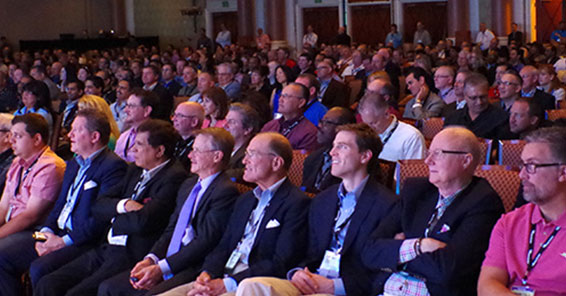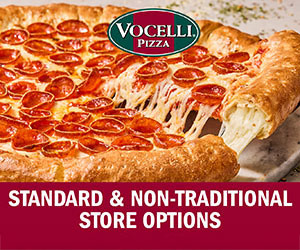Revive and Refresh: How Remodels can Drive Revenue for Franchisees

Just before the onset of the Covid-19 pandemic, Jersey Mike’s Subs Founder and CEO Peter Cancro stood in front of a group of franchise owners and announced an aggressive plan for growing the brand’s customer base and increasing revenue. Mitch Cohen, who operated six Jersey Mike’s locations at the time, was among those in the room.
Everyone knew that Cancro was an entrepreneurial genius. This was a guy who, as a 17-year-old in 1975, borrowed $125,000 from his coach to buy a single sub shop in Point Pleasant, New Jersey. By 2020, he had turned the business into an empire of more than 1,800 Jersey Mike’s Subs locations.
Still, when Cancro said he wanted to update the look of all of the restaurants and that the facelifts should start right away, Cohen balked.
All of them?
And not on the timetable dictated by the owners’ individual franchise agreements?
Cohen raised his hand. He had purchased his most recent location six months earlier. Per his agreement, he had almost five years before he was required to refresh the restaurant. “I’m not willing to remodel,” he recalls saying.
Then, something extraordinary happened.
Cancro “announced his plan to pay for the remodels across the country, which is extremely unique that a brand would do that,” says Cohen, who’d been in franchising for 35 years at that point. He says it gave “everybody the incentive to remodel since it wasn’t coming out of their pocket.”
Cancro couldn’t have known about the coming global pandemic, but it didn’t slow him down. He stuck with his aggressive plan, and in 18 months, every Jersey Mike’s location sported a new look.
Anyone who questions the difference a change in a business’ appearance can make should listen to Cohen. “The results for that remodel have been remarkable,” he says.
In what way?
“Customer perception,” Cohen says. “When they walked in, all the customers were like, ‘Wow, this is beautiful. What an upgrade.’
“Sales-wise, we’ve had almost double-digit increases for the past three years in our market. This year, it slowed down a little bit, but we’ve grown our customer base. Part of the result is, obviously, advertising and marketing. But the other part of the result came from the way the store looks, the atmosphere, the way the employees are dressed in their uniforms. I think it all tends to elevate the customer perception of our brand, which gives us an opportunity to be a premium sub shop versus just a quick-service sub shop.”
Brands and their franchisees are constantly looking for ways to gain a competitive advantage. They know that enhancing the customer experience can also enhance the bottom line. With that said, it can be expensive and disruptive for franchisees if elevating the customer experience or making a business more efficient involves investing in a new look, new equipment, or a new layout. Franchisees are always weighing the potential long-term benefits of improvements against the potential short-term pain.
As Taco Bell franchisee David Ostrowe says, “I’m disrupting my current customers for several weeks. I have a construction container in the parking lot. The place looks semi-closed as we’re going through this process. And so, because of the construction, my customers will go to my competitors. There’s a sales hit that franchisees take during these periods. And sometimes, if your competitors do a great job, it takes a long time to win those customers back.”
At the same time, Ostrowe knows that smart investments can deliver clear returns. But what’s a smart investment? Exactly what benefits have franchise operators reaped from remodeling or renovating their establishments? We talked to a few to find out.
In the customer's shoes
Franchisors often require their franchisees to pay for updates and upgrades to their businesses. Brands say that’s imperative in an industry that relies on maintaining consistency and staying on top of market trends.
“A lot of times, it revolves around new equipment. Maybe new products are being rolled out, and you couldn’t put them in because your electric upgrade wasn’t there,” Cohen says. “Or the layout wasn’t correct to bring in the new equipment that you needed to produce the new product line.”
These mandated times aren’t the only occasions when franchisees invest in improvements or new equipment.
“It really depends on where you are in the marketplace,” Cohen says. “What are your competitors doing? Do you have new competitors coming in? Let’s say your store has a lot of traffic, and things are getting worn down. You kind of have to step back and walk through the front door in the guest’s shoes and see what they see. From a customer’s point of view, does it look drab or worn? Do your ceiling tiles have water stains on them because you had a leak? These are things that, a lot of times, you put blinders on, and you just don’t see.”
New lighting, a more modern decor, and comfortable chairs can make customers want to stay longer and spend more. Nice landscaping can improve a business’ curb appeal. Energy-efficient equipment saves money.
Jersey Mike’s footed the bill for a bright beach decor by investing in new tables, chairs, counters, tile, and artwork as well as ordering devices. The company spent an average of $75,000 per store. It didn’t cost franchisees a thing, and the results were impressive.
Jersey Mike’s went from $850,000 unit volume in January 2020 to a projected $1.2 million average unit volume in January 2022, Cancro told Restaurant Business in 2021. “That’s an unprecedented rise,” he said then.
In addition, the disruption was minimal. Each of Cohen’s restaurants took about five days to complete. The Long Island franchisee now owns eight Jersey Mike’s stores and is in the process of building a ninth. He also has three Sola Salon Studios in New York and plans to open a fourth.
At the salons, he says, “We are constantly evaluating the locations and putting a fresh coat of paint on the wall in the hallways or looking at the carpeting to make sure that it’s not worn out.
“Our customers are the beauty pros. Their customers are their clients. And their clients need to feel warm and welcomed and be in a clean place when they’re getting their hair done or their eyes done. We refresh a little bit more frequently than we probably would at a restaurant. A restaurant is built to withstand more commercial traffic.”
Again, he says, franchisees must try to see what their customers see when they walk through the door.
Shifting dynamics
Ostrowe owns 27 Taco Bell restaurants in the Oklahoma City metro area. He’s in the middle of building one from the ground up with a new design that will serve as a test case for the brand. It will be used to assess whether the return on investment validates the cost of construction.
Ostrowe, who sits on the Taco Bell Franchise Association Board, is also in the middle of a remodel of one of his restaurants. It’s 8 years old, and the refresh will cost him somewhere around $200,000. In the near future, several of his restaurants are scheduled for similar brand-required remodeling.
He’s found that investments in the outside of his establishments, not the dining rooms, bring the most bang for the buck.
“Our numbers, post-Covid, have really shifted: 90% of our traffic is coming through the drive-thrus or deliveries. Only 10% of our traffic is in dining rooms. Anything I can do to enhance the delivery and drive-thru experience drives transactions long-term,” Ostrowe says.
Parking lots need LED lighting. Parking spaces should be well striped, and potholes are a no-no. Everything needs to be welcoming, especially the landscaping, so no one is hesitant to pull into the parking lot.
“Once they’re there,” Ostrowe says, “it’s utilizing technology to efficiently take an order to get people through the line and making sure that they get everything they need and the order is accurate.”
He’s invested in dual drive-thru lanes and dual menu boards. That has increased sales if only because of the psychological effect. “The consumers feel like they’re getting in line faster. They see two lanes in operation, and they see the line moving forward,” he says, adding that it’s also important to have an awning in place to cover customers during inclement weather.
Customers notice spiffed-up businesses. “I typically see between 8% to 10% return on the asset,” Ostrowe says.
Some benefits go beyond increased traffic. “We also see better employee satisfaction because they feel that you care,” he says. “If you’re neglecting your restaurant, your capital repairs, and things of that nature, employees see that, and they don’t like it. Employees want to have a place that feels good. So, there’s a soft benefit to these remodels because it excites the teams.”
Most franchisees understand the necessity of keeping their properties in good shape, Ostrowe says.
“In a good franchise community, coupled with a good franchisor, everybody’s addressing these assets and taking care of them,” he says. “The last thing you want is a franchisee who’s not spending money in any of their restaurants and has restaurants that aren’t up to par. If consumers have a bad experience at another franchise location—from an image perspective, an operational perspective—they’ll quit shopping with me. So, we are tied together.”
Restaurants go through a lot of wear and tear. If new lighting and paint with better equipment will bump up sales, franchisees are all in favor, whether the update was mandated or not. But, he says, not every franchisor-mandated change makes sense.
“I think sometimes the design people in different franchise groups come up with things that you’ve got to scratch your head at and will make you ask, Why are we spending money on this instead of spending money on that?” he says.
There’s an added complication: No matter how well planned a remodel is, surprises can pop up, especially when improvements require crews to go inside a wall.
“What we’ve run into several times on buildings that we acquired and did not build ourselves is we pulled off the old wainscoting and found rotted wood in the substructure,” Ostrowe says. “We went in for a one-week dining room refresh, and in those cases, it can go on as long as three weeks. All of a sudden, we’re now replacing walls or replacing windows that were not part of the original scope.”
While those are problems Ostrowe wants to address and would have sooner if he had known, the unexpected issue makes for a more expensive and time-consuming remodel. But when it’s over, there are reasons to smile.
“It gives the restaurants an opportunity to show the best that they can do,” he says, “because customers are excited about the remodel. Employees are excited about the remodel. Let’s put that excitement together to get a good return on the investment.”
Creating a buzz
Since November 2024, Anytime Fitness franchisee Andrew Breton has remodeled four of his 19 gyms. In his most recent project, he made extensive improvements at a newly acquired Anytime Fitness in Manchester, Connecticut. He closed the facility for nine days to refurbish.
“We’ve done remodels in the past, and we worked around the members, but it takes longer and gets a little messy,” Breton says. “By closing the gym down, we were able to do it quickly, and we were able to build a bit of a buzz. So, in a way, we did a mini presale. My team was able to get out into the community and talk to different businesses and other people and drive new people to us.”
Breton painted walls, installed new flooring and turf, invested in new cardio equipment, and expanded the weight room to meet growing demand. He also outfitted the center with the latest technology from Anytime Fitness, such as Myzone heart rate monitors and Evolt 360 body composition scanners, a tool for tracking muscle mass, body fat, total body water, and other health metrics.
He worked closely with the brand and took advantage of the research it had already done. Had he not been a part of a franchise, “it would have been a lot more work to figure out the color scheme and what people are liking these days,” he says. With the insights the brand provided, “that was all pretty easy in the sense that it was just kind of plug and play for the most part,” he says.
Breton was still years away from the remodeling required by the brand, but for him, it made sense to invest in the upgrades as soon as he took ownership of the gym. The facility was showing its age and losing members, he says.
“It didn’t have the tender loving care that it needed,” he says, adding that he wanted “to make sure that members understood that we value their business.”
He and his team looked at prior complaints about the gym and methodically addressed them. The remodeled fitness center opened in June. Breton has seen an increase in clients and revenue. He expects the remodel to pay for itself in six months.
That project and the three earlier remodels have proven to be worthwhile investments. The fresh look and new equipment increased customer satisfaction, made his employees happy and proud of the gym, and generated new business, he says. Next year, he plans to upgrade four more of his clubs and to proceed at that pace until they are all done.
“We’re looking to get about a 20% jump in revenue,” he says.
For a month before and a month after each of his remodeling projects, he invested more in marketing to build up anticipation in the community and the membership base. Breton also emphasized to his Anytime Fitness team members the potential upsides of the transformations.
“I really wanted to encourage people to treat this as a great sales opportunity,” he says.
Expert Insights
These franchising pros have advice for franchisees about to undertake a remodeling project.
MITCH COHEN, a Jersey Mike’s Subs and Sola Salon Studios multi-unit operator:
“Start preparing financially for a project well in advance. Don’t wait until three or six months out.”
“Plan it around a time of year when your business is slower than normal or when you can do a grand reopening to kick off your busy season.”
Understand the lead time, “whether it’s with permits, your contractor, or suppliers.”
Make sure “that you’re able to support your employees while you’re closed so that they’re not looking for another place to work.”
DAVID OSTROWE, a Taco Bell multi-unit operator:
“Open communication between the franchisee and the franchisor is absolutely critical, especially if you want to do something that’s different from the standard cookie-cutter.”
ANDREW BRETON, an Anytime Fitness multi-unit operator:
“Make sure that you’re treating it as a sales opportunity and not just as ‘I’ve got to remodel this building.’ The building is the building. The marketing, the hype, that’s what really gets you the buzz.”
Share this Feature
Recommended Reading:
| ADVERTISE | SPONSORED CONTENT |
FRANCHISE TOPICS
- Multi-Unit Franchising
- Get Started in Franchising
- Franchise Growth
- Franchise Operations
- Open New Units
- Franchise Leadership
- Franchise Marketing
- Technology
- Franchise Law
- Franchise Awards
- Franchise Rankings
- Franchise Trends
- Franchise Development
- Featured Franchise Stories
FEATURED IN

Multi-Unit Franchisee Magazine: Issue 4, 2025
| ADVERTISE | SPONSORED CONTENT |

$50,000
$250,000





 The multi-unit franchise opportunities listed above are not related to or endorsed by Multi-Unit Franchisee or Franchise Update Media Group. We are not engaged in, supporting, or endorsing any specific franchise, business opportunity, company or individual. No statement in this site is to be construed as a recommendation. We encourage prospective franchise buyers to perform extensive due diligence when considering a franchise opportunity.
The multi-unit franchise opportunities listed above are not related to or endorsed by Multi-Unit Franchisee or Franchise Update Media Group. We are not engaged in, supporting, or endorsing any specific franchise, business opportunity, company or individual. No statement in this site is to be construed as a recommendation. We encourage prospective franchise buyers to perform extensive due diligence when considering a franchise opportunity.